Strategic Analysis of Shaksy Group: External and Internal Factors
VerifiedAdded on 2021/04/16
|24
|5973
|66
Report
AI Summary
This report presents a strategic analysis of the Shaksy Group, a holding company based in Muscat, Oman, with interests in real estate, construction, and oil and gas. The analysis begins with an overview of the external environment, including industry trends, life cycles, market share concentration, demand determinants, and profitability drivers within these sectors. It then delves into a Porter's Five Forces analysis and a PEST analysis of the oil and gas industry. The internal analysis of Shaksy Group includes an examination of its core competencies, a SWOT analysis, and a value chain analysis (found in the appendix). The report concludes with a discussion of Shaksy Group's key strategies and provides recommendations for future development. Appendices provide additional data on oil and gas production trends and value chain analysis, offering a comprehensive overview of the company's strategic position and potential for growth within its diverse business operations.
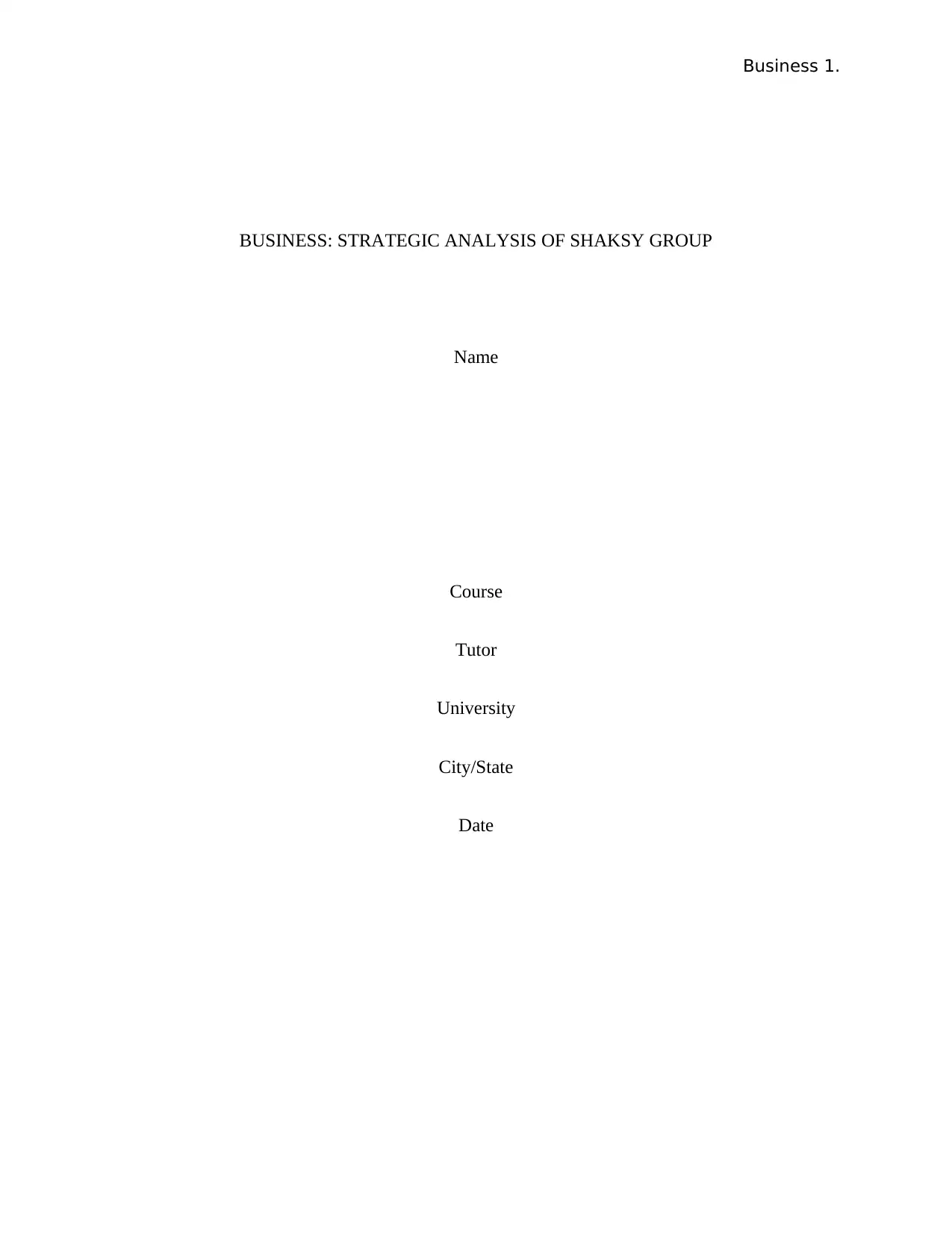
Business 1.
BUSINESS: STRATEGIC ANALYSIS OF SHAKSY GROUP
Name
Course
Tutor
University
City/State
Date
BUSINESS: STRATEGIC ANALYSIS OF SHAKSY GROUP
Name
Course
Tutor
University
City/State
Date
Paraphrase This Document
Need a fresh take? Get an instant paraphrase of this document with our AI Paraphraser
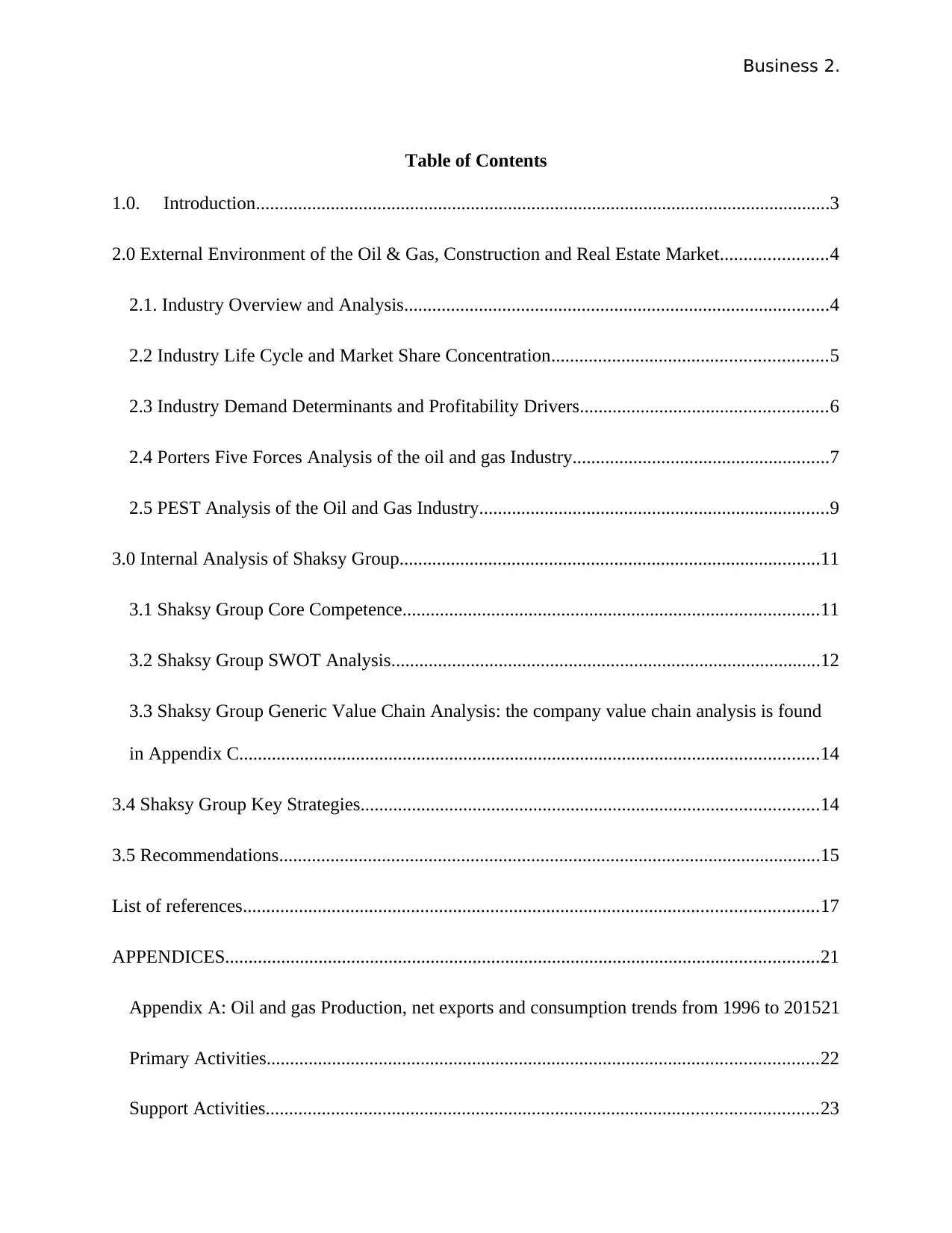
Business 2.
Table of Contents
1.0. Introduction...........................................................................................................................3
2.0 External Environment of the Oil & Gas, Construction and Real Estate Market.......................4
2.1. Industry Overview and Analysis...........................................................................................4
2.2 Industry Life Cycle and Market Share Concentration...........................................................5
2.3 Industry Demand Determinants and Profitability Drivers.....................................................6
2.4 Porters Five Forces Analysis of the oil and gas Industry.......................................................7
2.5 PEST Analysis of the Oil and Gas Industry...........................................................................9
3.0 Internal Analysis of Shaksy Group..........................................................................................11
3.1 Shaksy Group Core Competence.........................................................................................11
3.2 Shaksy Group SWOT Analysis............................................................................................12
3.3 Shaksy Group Generic Value Chain Analysis: the company value chain analysis is found
in Appendix C............................................................................................................................14
3.4 Shaksy Group Key Strategies..................................................................................................14
3.5 Recommendations....................................................................................................................15
List of references...........................................................................................................................17
APPENDICES...............................................................................................................................21
Appendix A: Oil and gas Production, net exports and consumption trends from 1996 to 201521
Primary Activities......................................................................................................................22
Support Activities......................................................................................................................23
Table of Contents
1.0. Introduction...........................................................................................................................3
2.0 External Environment of the Oil & Gas, Construction and Real Estate Market.......................4
2.1. Industry Overview and Analysis...........................................................................................4
2.2 Industry Life Cycle and Market Share Concentration...........................................................5
2.3 Industry Demand Determinants and Profitability Drivers.....................................................6
2.4 Porters Five Forces Analysis of the oil and gas Industry.......................................................7
2.5 PEST Analysis of the Oil and Gas Industry...........................................................................9
3.0 Internal Analysis of Shaksy Group..........................................................................................11
3.1 Shaksy Group Core Competence.........................................................................................11
3.2 Shaksy Group SWOT Analysis............................................................................................12
3.3 Shaksy Group Generic Value Chain Analysis: the company value chain analysis is found
in Appendix C............................................................................................................................14
3.4 Shaksy Group Key Strategies..................................................................................................14
3.5 Recommendations....................................................................................................................15
List of references...........................................................................................................................17
APPENDICES...............................................................................................................................21
Appendix A: Oil and gas Production, net exports and consumption trends from 1996 to 201521
Primary Activities......................................................................................................................22
Support Activities......................................................................................................................23
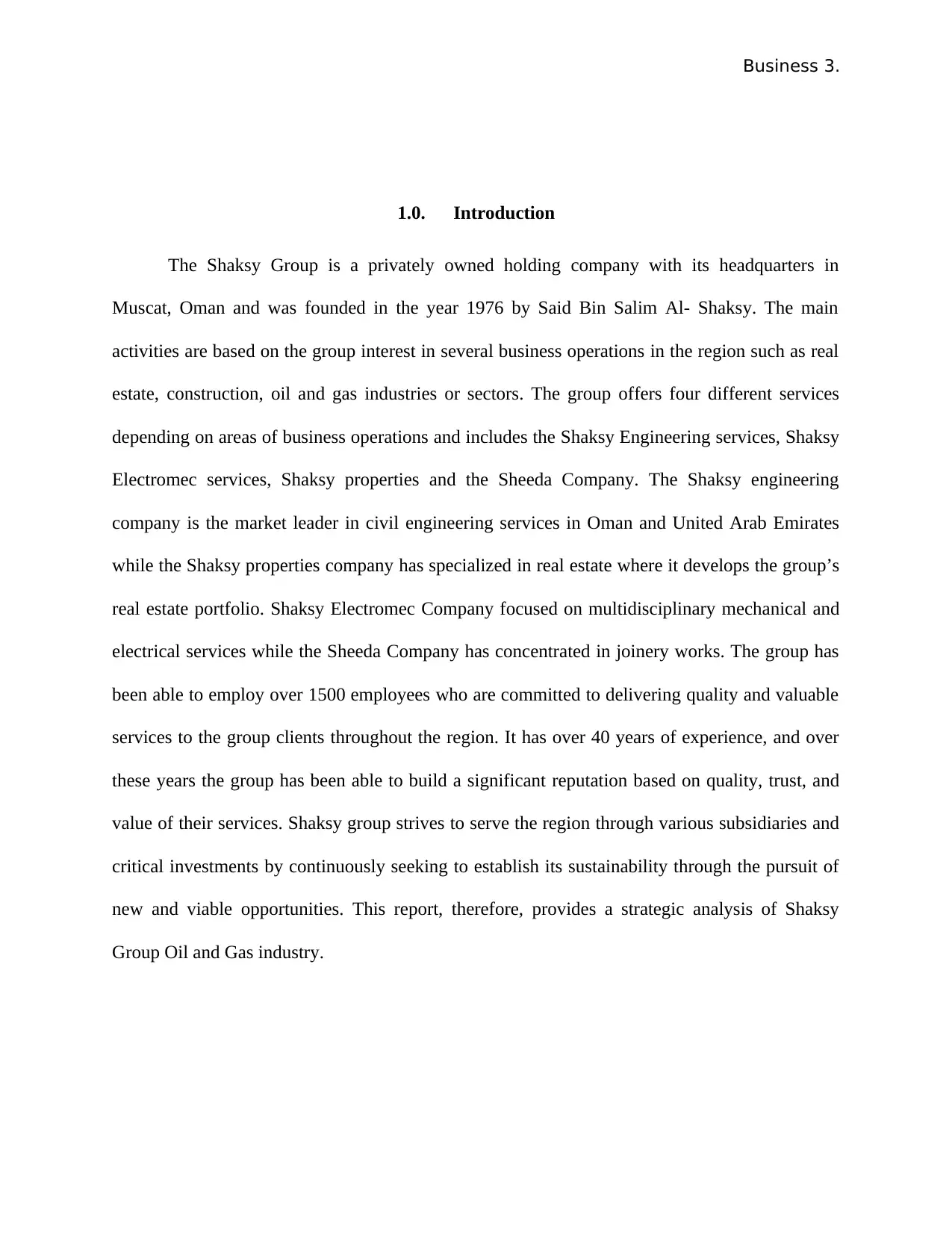
Business 3.
1.0. Introduction
The Shaksy Group is a privately owned holding company with its headquarters in
Muscat, Oman and was founded in the year 1976 by Said Bin Salim Al- Shaksy. The main
activities are based on the group interest in several business operations in the region such as real
estate, construction, oil and gas industries or sectors. The group offers four different services
depending on areas of business operations and includes the Shaksy Engineering services, Shaksy
Electromec services, Shaksy properties and the Sheeda Company. The Shaksy engineering
company is the market leader in civil engineering services in Oman and United Arab Emirates
while the Shaksy properties company has specialized in real estate where it develops the group’s
real estate portfolio. Shaksy Electromec Company focused on multidisciplinary mechanical and
electrical services while the Sheeda Company has concentrated in joinery works. The group has
been able to employ over 1500 employees who are committed to delivering quality and valuable
services to the group clients throughout the region. It has over 40 years of experience, and over
these years the group has been able to build a significant reputation based on quality, trust, and
value of their services. Shaksy group strives to serve the region through various subsidiaries and
critical investments by continuously seeking to establish its sustainability through the pursuit of
new and viable opportunities. This report, therefore, provides a strategic analysis of Shaksy
Group Oil and Gas industry.
1.0. Introduction
The Shaksy Group is a privately owned holding company with its headquarters in
Muscat, Oman and was founded in the year 1976 by Said Bin Salim Al- Shaksy. The main
activities are based on the group interest in several business operations in the region such as real
estate, construction, oil and gas industries or sectors. The group offers four different services
depending on areas of business operations and includes the Shaksy Engineering services, Shaksy
Electromec services, Shaksy properties and the Sheeda Company. The Shaksy engineering
company is the market leader in civil engineering services in Oman and United Arab Emirates
while the Shaksy properties company has specialized in real estate where it develops the group’s
real estate portfolio. Shaksy Electromec Company focused on multidisciplinary mechanical and
electrical services while the Sheeda Company has concentrated in joinery works. The group has
been able to employ over 1500 employees who are committed to delivering quality and valuable
services to the group clients throughout the region. It has over 40 years of experience, and over
these years the group has been able to build a significant reputation based on quality, trust, and
value of their services. Shaksy group strives to serve the region through various subsidiaries and
critical investments by continuously seeking to establish its sustainability through the pursuit of
new and viable opportunities. This report, therefore, provides a strategic analysis of Shaksy
Group Oil and Gas industry.
⊘ This is a preview!⊘
Do you want full access?
Subscribe today to unlock all pages.

Trusted by 1+ million students worldwide
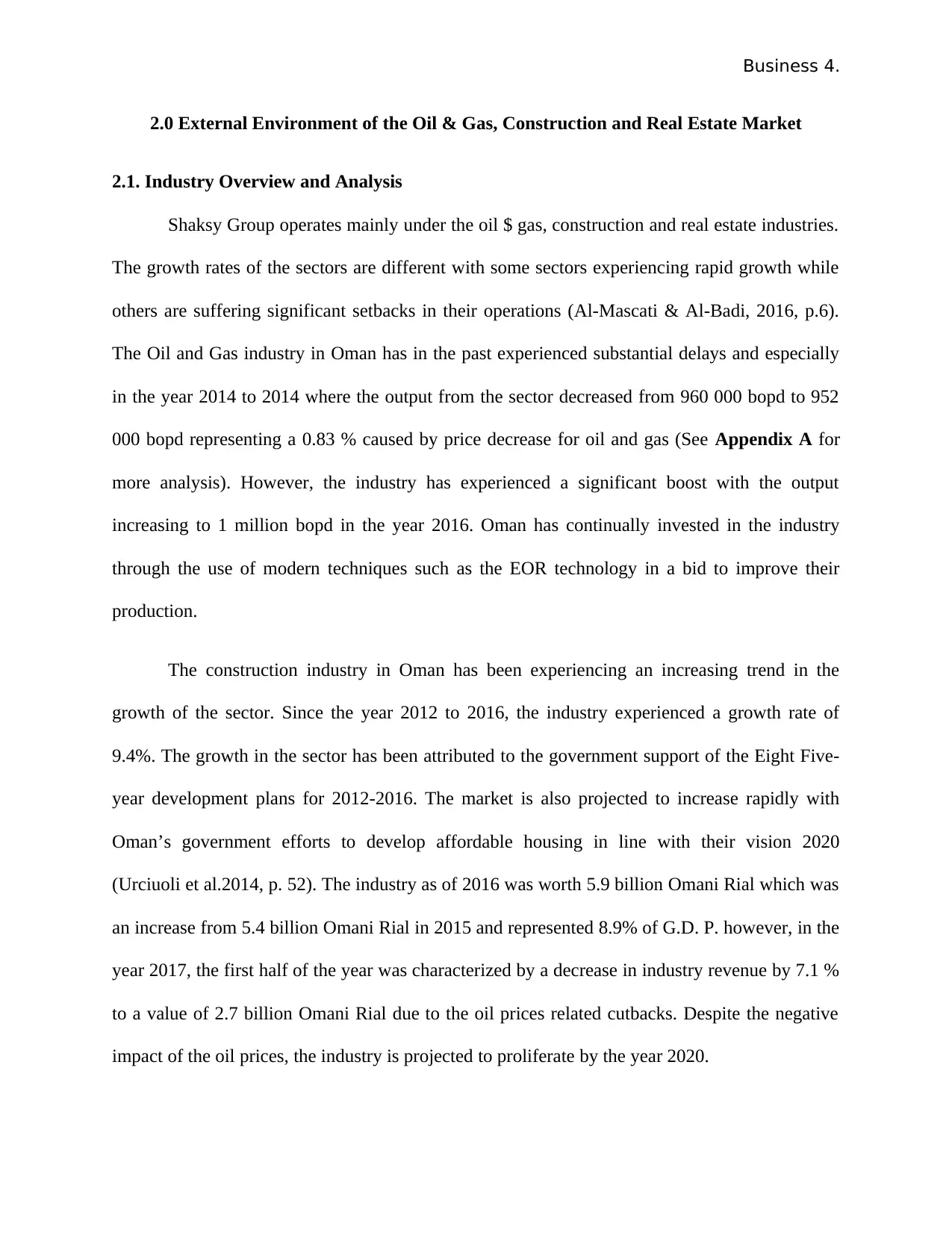
Business 4.
2.0 External Environment of the Oil & Gas, Construction and Real Estate Market
2.1. Industry Overview and Analysis
Shaksy Group operates mainly under the oil $ gas, construction and real estate industries.
The growth rates of the sectors are different with some sectors experiencing rapid growth while
others are suffering significant setbacks in their operations (Al-Mascati & Al-Badi, 2016, p.6).
The Oil and Gas industry in Oman has in the past experienced substantial delays and especially
in the year 2014 to 2014 where the output from the sector decreased from 960 000 bopd to 952
000 bopd representing a 0.83 % caused by price decrease for oil and gas (See Appendix A for
more analysis). However, the industry has experienced a significant boost with the output
increasing to 1 million bopd in the year 2016. Oman has continually invested in the industry
through the use of modern techniques such as the EOR technology in a bid to improve their
production.
The construction industry in Oman has been experiencing an increasing trend in the
growth of the sector. Since the year 2012 to 2016, the industry experienced a growth rate of
9.4%. The growth in the sector has been attributed to the government support of the Eight Five-
year development plans for 2012-2016. The market is also projected to increase rapidly with
Oman’s government efforts to develop affordable housing in line with their vision 2020
(Urciuoli et al.2014, p. 52). The industry as of 2016 was worth 5.9 billion Omani Rial which was
an increase from 5.4 billion Omani Rial in 2015 and represented 8.9% of G.D. P. however, in the
year 2017, the first half of the year was characterized by a decrease in industry revenue by 7.1 %
to a value of 2.7 billion Omani Rial due to the oil prices related cutbacks. Despite the negative
impact of the oil prices, the industry is projected to proliferate by the year 2020.
2.0 External Environment of the Oil & Gas, Construction and Real Estate Market
2.1. Industry Overview and Analysis
Shaksy Group operates mainly under the oil $ gas, construction and real estate industries.
The growth rates of the sectors are different with some sectors experiencing rapid growth while
others are suffering significant setbacks in their operations (Al-Mascati & Al-Badi, 2016, p.6).
The Oil and Gas industry in Oman has in the past experienced substantial delays and especially
in the year 2014 to 2014 where the output from the sector decreased from 960 000 bopd to 952
000 bopd representing a 0.83 % caused by price decrease for oil and gas (See Appendix A for
more analysis). However, the industry has experienced a significant boost with the output
increasing to 1 million bopd in the year 2016. Oman has continually invested in the industry
through the use of modern techniques such as the EOR technology in a bid to improve their
production.
The construction industry in Oman has been experiencing an increasing trend in the
growth of the sector. Since the year 2012 to 2016, the industry experienced a growth rate of
9.4%. The growth in the sector has been attributed to the government support of the Eight Five-
year development plans for 2012-2016. The market is also projected to increase rapidly with
Oman’s government efforts to develop affordable housing in line with their vision 2020
(Urciuoli et al.2014, p. 52). The industry as of 2016 was worth 5.9 billion Omani Rial which was
an increase from 5.4 billion Omani Rial in 2015 and represented 8.9% of G.D. P. however, in the
year 2017, the first half of the year was characterized by a decrease in industry revenue by 7.1 %
to a value of 2.7 billion Omani Rial due to the oil prices related cutbacks. Despite the negative
impact of the oil prices, the industry is projected to proliferate by the year 2020.
Paraphrase This Document
Need a fresh take? Get an instant paraphrase of this document with our AI Paraphraser
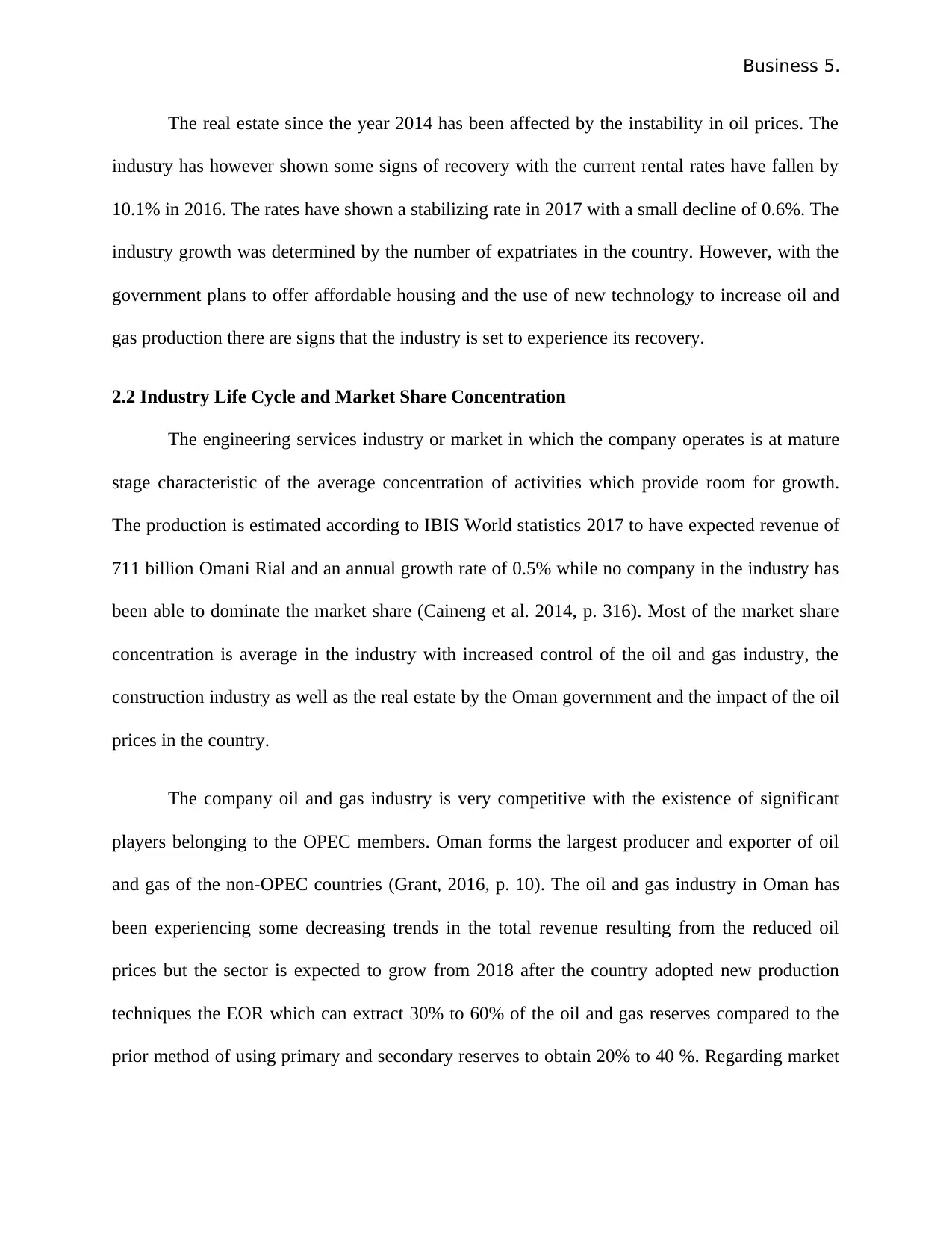
Business 5.
The real estate since the year 2014 has been affected by the instability in oil prices. The
industry has however shown some signs of recovery with the current rental rates have fallen by
10.1% in 2016. The rates have shown a stabilizing rate in 2017 with a small decline of 0.6%. The
industry growth was determined by the number of expatriates in the country. However, with the
government plans to offer affordable housing and the use of new technology to increase oil and
gas production there are signs that the industry is set to experience its recovery.
2.2 Industry Life Cycle and Market Share Concentration
The engineering services industry or market in which the company operates is at mature
stage characteristic of the average concentration of activities which provide room for growth.
The production is estimated according to IBIS World statistics 2017 to have expected revenue of
711 billion Omani Rial and an annual growth rate of 0.5% while no company in the industry has
been able to dominate the market share (Caineng et al. 2014, p. 316). Most of the market share
concentration is average in the industry with increased control of the oil and gas industry, the
construction industry as well as the real estate by the Oman government and the impact of the oil
prices in the country.
The company oil and gas industry is very competitive with the existence of significant
players belonging to the OPEC members. Oman forms the largest producer and exporter of oil
and gas of the non-OPEC countries (Grant, 2016, p. 10). The oil and gas industry in Oman has
been experiencing some decreasing trends in the total revenue resulting from the reduced oil
prices but the sector is expected to grow from 2018 after the country adopted new production
techniques the EOR which can extract 30% to 60% of the oil and gas reserves compared to the
prior method of using primary and secondary reserves to obtain 20% to 40 %. Regarding market
The real estate since the year 2014 has been affected by the instability in oil prices. The
industry has however shown some signs of recovery with the current rental rates have fallen by
10.1% in 2016. The rates have shown a stabilizing rate in 2017 with a small decline of 0.6%. The
industry growth was determined by the number of expatriates in the country. However, with the
government plans to offer affordable housing and the use of new technology to increase oil and
gas production there are signs that the industry is set to experience its recovery.
2.2 Industry Life Cycle and Market Share Concentration
The engineering services industry or market in which the company operates is at mature
stage characteristic of the average concentration of activities which provide room for growth.
The production is estimated according to IBIS World statistics 2017 to have expected revenue of
711 billion Omani Rial and an annual growth rate of 0.5% while no company in the industry has
been able to dominate the market share (Caineng et al. 2014, p. 316). Most of the market share
concentration is average in the industry with increased control of the oil and gas industry, the
construction industry as well as the real estate by the Oman government and the impact of the oil
prices in the country.
The company oil and gas industry is very competitive with the existence of significant
players belonging to the OPEC members. Oman forms the largest producer and exporter of oil
and gas of the non-OPEC countries (Grant, 2016, p. 10). The oil and gas industry in Oman has
been experiencing some decreasing trends in the total revenue resulting from the reduced oil
prices but the sector is expected to grow from 2018 after the country adopted new production
techniques the EOR which can extract 30% to 60% of the oil and gas reserves compared to the
prior method of using primary and secondary reserves to obtain 20% to 40 %. Regarding market
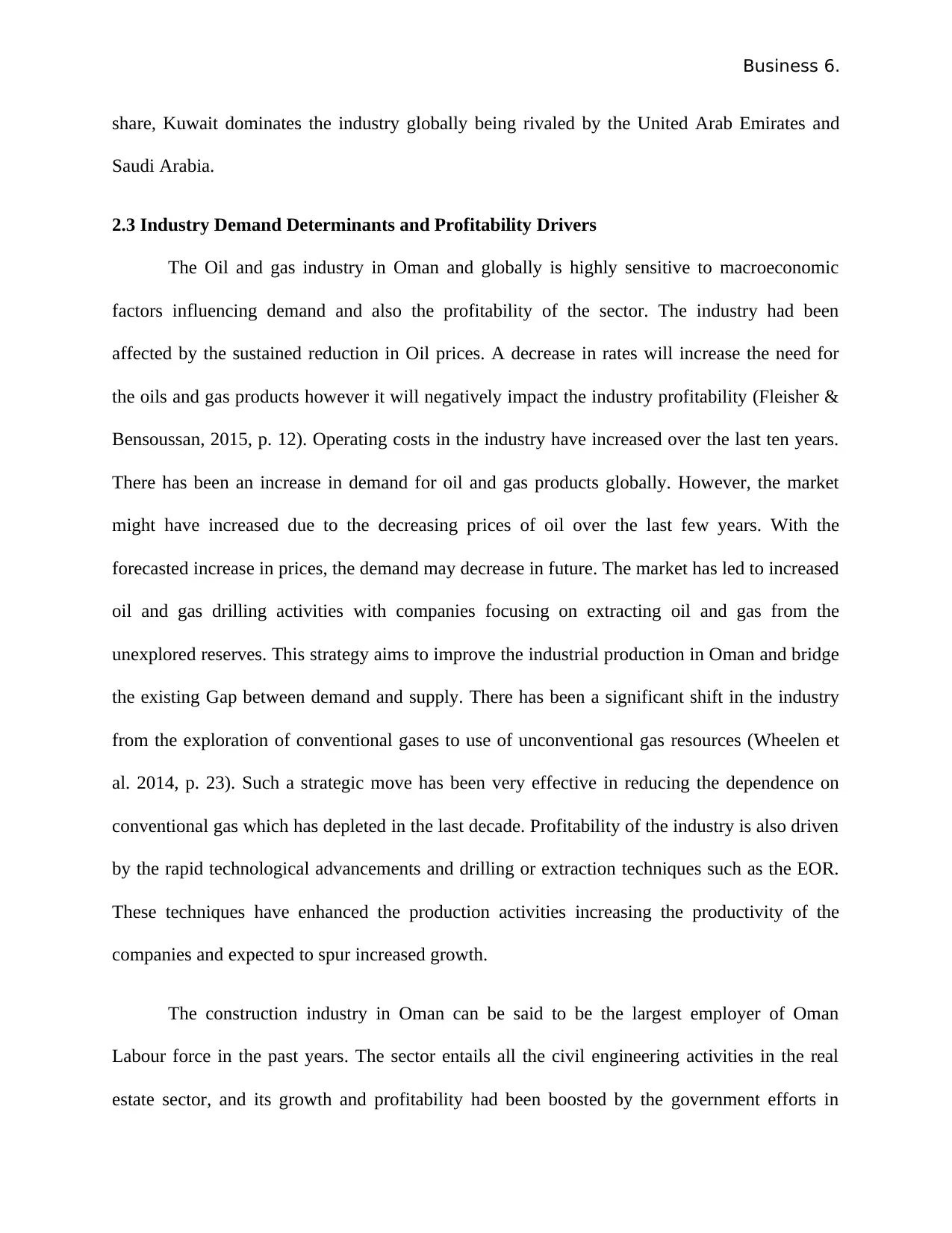
Business 6.
share, Kuwait dominates the industry globally being rivaled by the United Arab Emirates and
Saudi Arabia.
2.3 Industry Demand Determinants and Profitability Drivers
The Oil and gas industry in Oman and globally is highly sensitive to macroeconomic
factors influencing demand and also the profitability of the sector. The industry had been
affected by the sustained reduction in Oil prices. A decrease in rates will increase the need for
the oils and gas products however it will negatively impact the industry profitability (Fleisher &
Bensoussan, 2015, p. 12). Operating costs in the industry have increased over the last ten years.
There has been an increase in demand for oil and gas products globally. However, the market
might have increased due to the decreasing prices of oil over the last few years. With the
forecasted increase in prices, the demand may decrease in future. The market has led to increased
oil and gas drilling activities with companies focusing on extracting oil and gas from the
unexplored reserves. This strategy aims to improve the industrial production in Oman and bridge
the existing Gap between demand and supply. There has been a significant shift in the industry
from the exploration of conventional gases to use of unconventional gas resources (Wheelen et
al. 2014, p. 23). Such a strategic move has been very effective in reducing the dependence on
conventional gas which has depleted in the last decade. Profitability of the industry is also driven
by the rapid technological advancements and drilling or extraction techniques such as the EOR.
These techniques have enhanced the production activities increasing the productivity of the
companies and expected to spur increased growth.
The construction industry in Oman can be said to be the largest employer of Oman
Labour force in the past years. The sector entails all the civil engineering activities in the real
estate sector, and its growth and profitability had been boosted by the government efforts in
share, Kuwait dominates the industry globally being rivaled by the United Arab Emirates and
Saudi Arabia.
2.3 Industry Demand Determinants and Profitability Drivers
The Oil and gas industry in Oman and globally is highly sensitive to macroeconomic
factors influencing demand and also the profitability of the sector. The industry had been
affected by the sustained reduction in Oil prices. A decrease in rates will increase the need for
the oils and gas products however it will negatively impact the industry profitability (Fleisher &
Bensoussan, 2015, p. 12). Operating costs in the industry have increased over the last ten years.
There has been an increase in demand for oil and gas products globally. However, the market
might have increased due to the decreasing prices of oil over the last few years. With the
forecasted increase in prices, the demand may decrease in future. The market has led to increased
oil and gas drilling activities with companies focusing on extracting oil and gas from the
unexplored reserves. This strategy aims to improve the industrial production in Oman and bridge
the existing Gap between demand and supply. There has been a significant shift in the industry
from the exploration of conventional gases to use of unconventional gas resources (Wheelen et
al. 2014, p. 23). Such a strategic move has been very effective in reducing the dependence on
conventional gas which has depleted in the last decade. Profitability of the industry is also driven
by the rapid technological advancements and drilling or extraction techniques such as the EOR.
These techniques have enhanced the production activities increasing the productivity of the
companies and expected to spur increased growth.
The construction industry in Oman can be said to be the largest employer of Oman
Labour force in the past years. The sector entails all the civil engineering activities in the real
estate sector, and its growth and profitability had been boosted by the government efforts in
⊘ This is a preview!⊘
Do you want full access?
Subscribe today to unlock all pages.

Trusted by 1+ million students worldwide
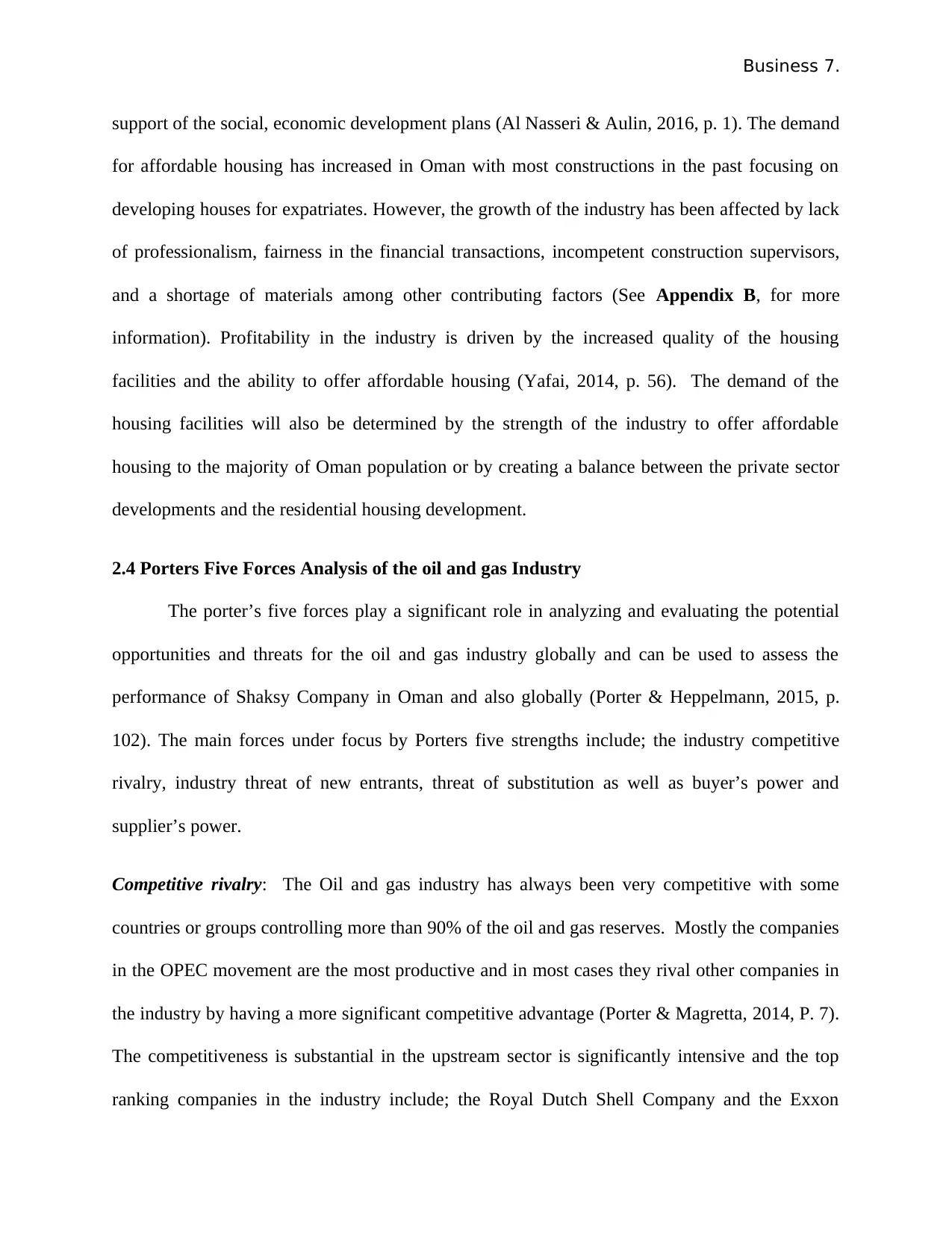
Business 7.
support of the social, economic development plans (Al Nasseri & Aulin, 2016, p. 1). The demand
for affordable housing has increased in Oman with most constructions in the past focusing on
developing houses for expatriates. However, the growth of the industry has been affected by lack
of professionalism, fairness in the financial transactions, incompetent construction supervisors,
and a shortage of materials among other contributing factors (See Appendix B, for more
information). Profitability in the industry is driven by the increased quality of the housing
facilities and the ability to offer affordable housing (Yafai, 2014, p. 56). The demand of the
housing facilities will also be determined by the strength of the industry to offer affordable
housing to the majority of Oman population or by creating a balance between the private sector
developments and the residential housing development.
2.4 Porters Five Forces Analysis of the oil and gas Industry
The porter’s five forces play a significant role in analyzing and evaluating the potential
opportunities and threats for the oil and gas industry globally and can be used to assess the
performance of Shaksy Company in Oman and also globally (Porter & Heppelmann, 2015, p.
102). The main forces under focus by Porters five strengths include; the industry competitive
rivalry, industry threat of new entrants, threat of substitution as well as buyer’s power and
supplier’s power.
Competitive rivalry: The Oil and gas industry has always been very competitive with some
countries or groups controlling more than 90% of the oil and gas reserves. Mostly the companies
in the OPEC movement are the most productive and in most cases they rival other companies in
the industry by having a more significant competitive advantage (Porter & Magretta, 2014, P. 7).
The competitiveness is substantial in the upstream sector is significantly intensive and the top
ranking companies in the industry include; the Royal Dutch Shell Company and the Exxon
support of the social, economic development plans (Al Nasseri & Aulin, 2016, p. 1). The demand
for affordable housing has increased in Oman with most constructions in the past focusing on
developing houses for expatriates. However, the growth of the industry has been affected by lack
of professionalism, fairness in the financial transactions, incompetent construction supervisors,
and a shortage of materials among other contributing factors (See Appendix B, for more
information). Profitability in the industry is driven by the increased quality of the housing
facilities and the ability to offer affordable housing (Yafai, 2014, p. 56). The demand of the
housing facilities will also be determined by the strength of the industry to offer affordable
housing to the majority of Oman population or by creating a balance between the private sector
developments and the residential housing development.
2.4 Porters Five Forces Analysis of the oil and gas Industry
The porter’s five forces play a significant role in analyzing and evaluating the potential
opportunities and threats for the oil and gas industry globally and can be used to assess the
performance of Shaksy Company in Oman and also globally (Porter & Heppelmann, 2015, p.
102). The main forces under focus by Porters five strengths include; the industry competitive
rivalry, industry threat of new entrants, threat of substitution as well as buyer’s power and
supplier’s power.
Competitive rivalry: The Oil and gas industry has always been very competitive with some
countries or groups controlling more than 90% of the oil and gas reserves. Mostly the companies
in the OPEC movement are the most productive and in most cases they rival other companies in
the industry by having a more significant competitive advantage (Porter & Magretta, 2014, P. 7).
The competitiveness is substantial in the upstream sector is significantly intensive and the top
ranking companies in the industry include; the Royal Dutch Shell Company and the Exxon
Paraphrase This Document
Need a fresh take? Get an instant paraphrase of this document with our AI Paraphraser
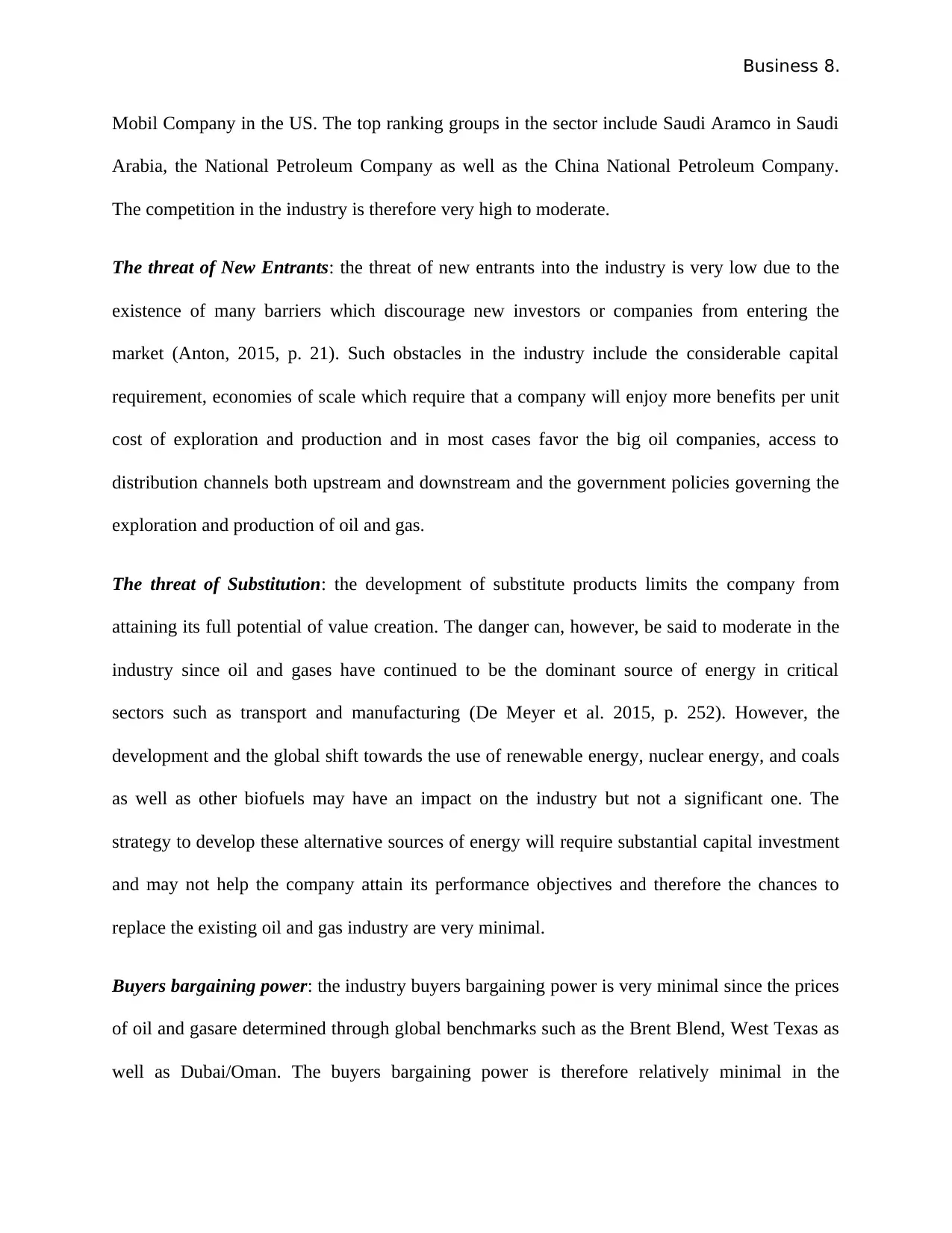
Business 8.
Mobil Company in the US. The top ranking groups in the sector include Saudi Aramco in Saudi
Arabia, the National Petroleum Company as well as the China National Petroleum Company.
The competition in the industry is therefore very high to moderate.
The threat of New Entrants: the threat of new entrants into the industry is very low due to the
existence of many barriers which discourage new investors or companies from entering the
market (Anton, 2015, p. 21). Such obstacles in the industry include the considerable capital
requirement, economies of scale which require that a company will enjoy more benefits per unit
cost of exploration and production and in most cases favor the big oil companies, access to
distribution channels both upstream and downstream and the government policies governing the
exploration and production of oil and gas.
The threat of Substitution: the development of substitute products limits the company from
attaining its full potential of value creation. The danger can, however, be said to moderate in the
industry since oil and gases have continued to be the dominant source of energy in critical
sectors such as transport and manufacturing (De Meyer et al. 2015, p. 252). However, the
development and the global shift towards the use of renewable energy, nuclear energy, and coals
as well as other biofuels may have an impact on the industry but not a significant one. The
strategy to develop these alternative sources of energy will require substantial capital investment
and may not help the company attain its performance objectives and therefore the chances to
replace the existing oil and gas industry are very minimal.
Buyers bargaining power: the industry buyers bargaining power is very minimal since the prices
of oil and gasare determined through global benchmarks such as the Brent Blend, West Texas as
well as Dubai/Oman. The buyers bargaining power is therefore relatively minimal in the
Mobil Company in the US. The top ranking groups in the sector include Saudi Aramco in Saudi
Arabia, the National Petroleum Company as well as the China National Petroleum Company.
The competition in the industry is therefore very high to moderate.
The threat of New Entrants: the threat of new entrants into the industry is very low due to the
existence of many barriers which discourage new investors or companies from entering the
market (Anton, 2015, p. 21). Such obstacles in the industry include the considerable capital
requirement, economies of scale which require that a company will enjoy more benefits per unit
cost of exploration and production and in most cases favor the big oil companies, access to
distribution channels both upstream and downstream and the government policies governing the
exploration and production of oil and gas.
The threat of Substitution: the development of substitute products limits the company from
attaining its full potential of value creation. The danger can, however, be said to moderate in the
industry since oil and gases have continued to be the dominant source of energy in critical
sectors such as transport and manufacturing (De Meyer et al. 2015, p. 252). However, the
development and the global shift towards the use of renewable energy, nuclear energy, and coals
as well as other biofuels may have an impact on the industry but not a significant one. The
strategy to develop these alternative sources of energy will require substantial capital investment
and may not help the company attain its performance objectives and therefore the chances to
replace the existing oil and gas industry are very minimal.
Buyers bargaining power: the industry buyers bargaining power is very minimal since the prices
of oil and gasare determined through global benchmarks such as the Brent Blend, West Texas as
well as Dubai/Oman. The buyers bargaining power is therefore relatively minimal in the
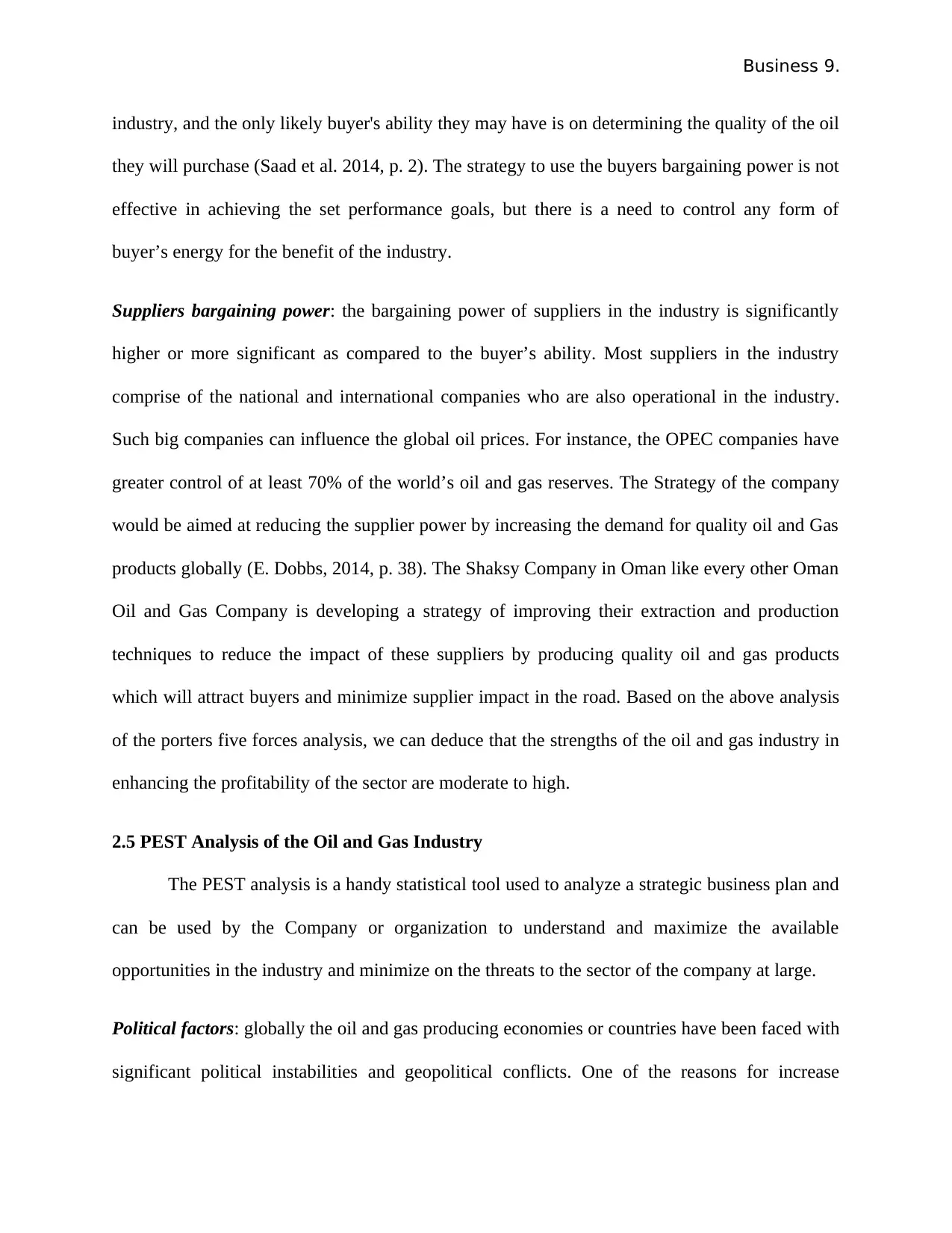
Business 9.
industry, and the only likely buyer's ability they may have is on determining the quality of the oil
they will purchase (Saad et al. 2014, p. 2). The strategy to use the buyers bargaining power is not
effective in achieving the set performance goals, but there is a need to control any form of
buyer’s energy for the benefit of the industry.
Suppliers bargaining power: the bargaining power of suppliers in the industry is significantly
higher or more significant as compared to the buyer’s ability. Most suppliers in the industry
comprise of the national and international companies who are also operational in the industry.
Such big companies can influence the global oil prices. For instance, the OPEC companies have
greater control of at least 70% of the world’s oil and gas reserves. The Strategy of the company
would be aimed at reducing the supplier power by increasing the demand for quality oil and Gas
products globally (E. Dobbs, 2014, p. 38). The Shaksy Company in Oman like every other Oman
Oil and Gas Company is developing a strategy of improving their extraction and production
techniques to reduce the impact of these suppliers by producing quality oil and gas products
which will attract buyers and minimize supplier impact in the road. Based on the above analysis
of the porters five forces analysis, we can deduce that the strengths of the oil and gas industry in
enhancing the profitability of the sector are moderate to high.
2.5 PEST Analysis of the Oil and Gas Industry
The PEST analysis is a handy statistical tool used to analyze a strategic business plan and
can be used by the Company or organization to understand and maximize the available
opportunities in the industry and minimize on the threats to the sector of the company at large.
Political factors: globally the oil and gas producing economies or countries have been faced with
significant political instabilities and geopolitical conflicts. One of the reasons for increase
industry, and the only likely buyer's ability they may have is on determining the quality of the oil
they will purchase (Saad et al. 2014, p. 2). The strategy to use the buyers bargaining power is not
effective in achieving the set performance goals, but there is a need to control any form of
buyer’s energy for the benefit of the industry.
Suppliers bargaining power: the bargaining power of suppliers in the industry is significantly
higher or more significant as compared to the buyer’s ability. Most suppliers in the industry
comprise of the national and international companies who are also operational in the industry.
Such big companies can influence the global oil prices. For instance, the OPEC companies have
greater control of at least 70% of the world’s oil and gas reserves. The Strategy of the company
would be aimed at reducing the supplier power by increasing the demand for quality oil and Gas
products globally (E. Dobbs, 2014, p. 38). The Shaksy Company in Oman like every other Oman
Oil and Gas Company is developing a strategy of improving their extraction and production
techniques to reduce the impact of these suppliers by producing quality oil and gas products
which will attract buyers and minimize supplier impact in the road. Based on the above analysis
of the porters five forces analysis, we can deduce that the strengths of the oil and gas industry in
enhancing the profitability of the sector are moderate to high.
2.5 PEST Analysis of the Oil and Gas Industry
The PEST analysis is a handy statistical tool used to analyze a strategic business plan and
can be used by the Company or organization to understand and maximize the available
opportunities in the industry and minimize on the threats to the sector of the company at large.
Political factors: globally the oil and gas producing economies or countries have been faced with
significant political instabilities and geopolitical conflicts. One of the reasons for increase
⊘ This is a preview!⊘
Do you want full access?
Subscribe today to unlock all pages.

Trusted by 1+ million students worldwide
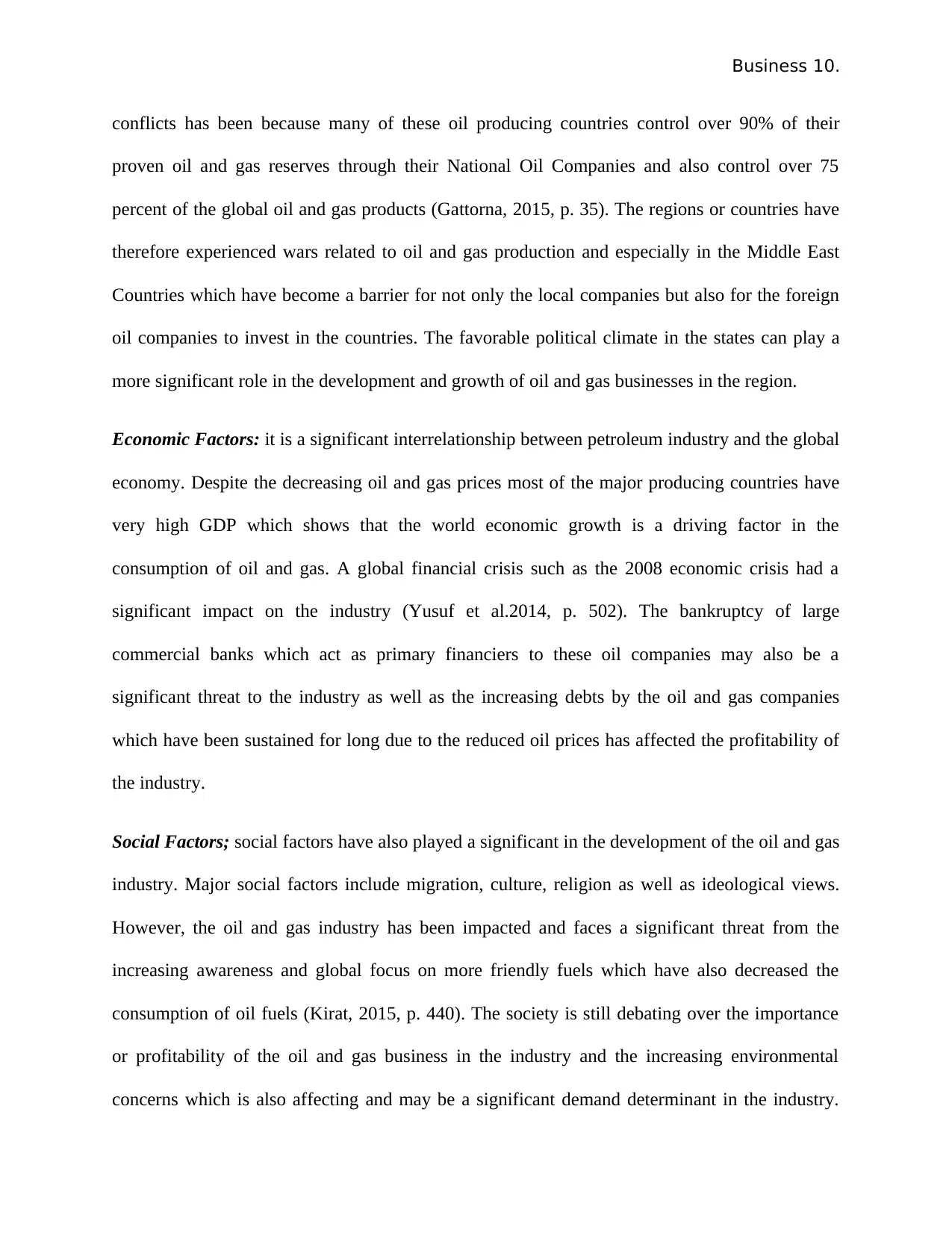
Business 10.
conflicts has been because many of these oil producing countries control over 90% of their
proven oil and gas reserves through their National Oil Companies and also control over 75
percent of the global oil and gas products (Gattorna, 2015, p. 35). The regions or countries have
therefore experienced wars related to oil and gas production and especially in the Middle East
Countries which have become a barrier for not only the local companies but also for the foreign
oil companies to invest in the countries. The favorable political climate in the states can play a
more significant role in the development and growth of oil and gas businesses in the region.
Economic Factors: it is a significant interrelationship between petroleum industry and the global
economy. Despite the decreasing oil and gas prices most of the major producing countries have
very high GDP which shows that the world economic growth is a driving factor in the
consumption of oil and gas. A global financial crisis such as the 2008 economic crisis had a
significant impact on the industry (Yusuf et al.2014, p. 502). The bankruptcy of large
commercial banks which act as primary financiers to these oil companies may also be a
significant threat to the industry as well as the increasing debts by the oil and gas companies
which have been sustained for long due to the reduced oil prices has affected the profitability of
the industry.
Social Factors; social factors have also played a significant in the development of the oil and gas
industry. Major social factors include migration, culture, religion as well as ideological views.
However, the oil and gas industry has been impacted and faces a significant threat from the
increasing awareness and global focus on more friendly fuels which have also decreased the
consumption of oil fuels (Kirat, 2015, p. 440). The society is still debating over the importance
or profitability of the oil and gas business in the industry and the increasing environmental
concerns which is also affecting and may be a significant demand determinant in the industry.
conflicts has been because many of these oil producing countries control over 90% of their
proven oil and gas reserves through their National Oil Companies and also control over 75
percent of the global oil and gas products (Gattorna, 2015, p. 35). The regions or countries have
therefore experienced wars related to oil and gas production and especially in the Middle East
Countries which have become a barrier for not only the local companies but also for the foreign
oil companies to invest in the countries. The favorable political climate in the states can play a
more significant role in the development and growth of oil and gas businesses in the region.
Economic Factors: it is a significant interrelationship between petroleum industry and the global
economy. Despite the decreasing oil and gas prices most of the major producing countries have
very high GDP which shows that the world economic growth is a driving factor in the
consumption of oil and gas. A global financial crisis such as the 2008 economic crisis had a
significant impact on the industry (Yusuf et al.2014, p. 502). The bankruptcy of large
commercial banks which act as primary financiers to these oil companies may also be a
significant threat to the industry as well as the increasing debts by the oil and gas companies
which have been sustained for long due to the reduced oil prices has affected the profitability of
the industry.
Social Factors; social factors have also played a significant in the development of the oil and gas
industry. Major social factors include migration, culture, religion as well as ideological views.
However, the oil and gas industry has been impacted and faces a significant threat from the
increasing awareness and global focus on more friendly fuels which have also decreased the
consumption of oil fuels (Kirat, 2015, p. 440). The society is still debating over the importance
or profitability of the oil and gas business in the industry and the increasing environmental
concerns which is also affecting and may be a significant demand determinant in the industry.
Paraphrase This Document
Need a fresh take? Get an instant paraphrase of this document with our AI Paraphraser
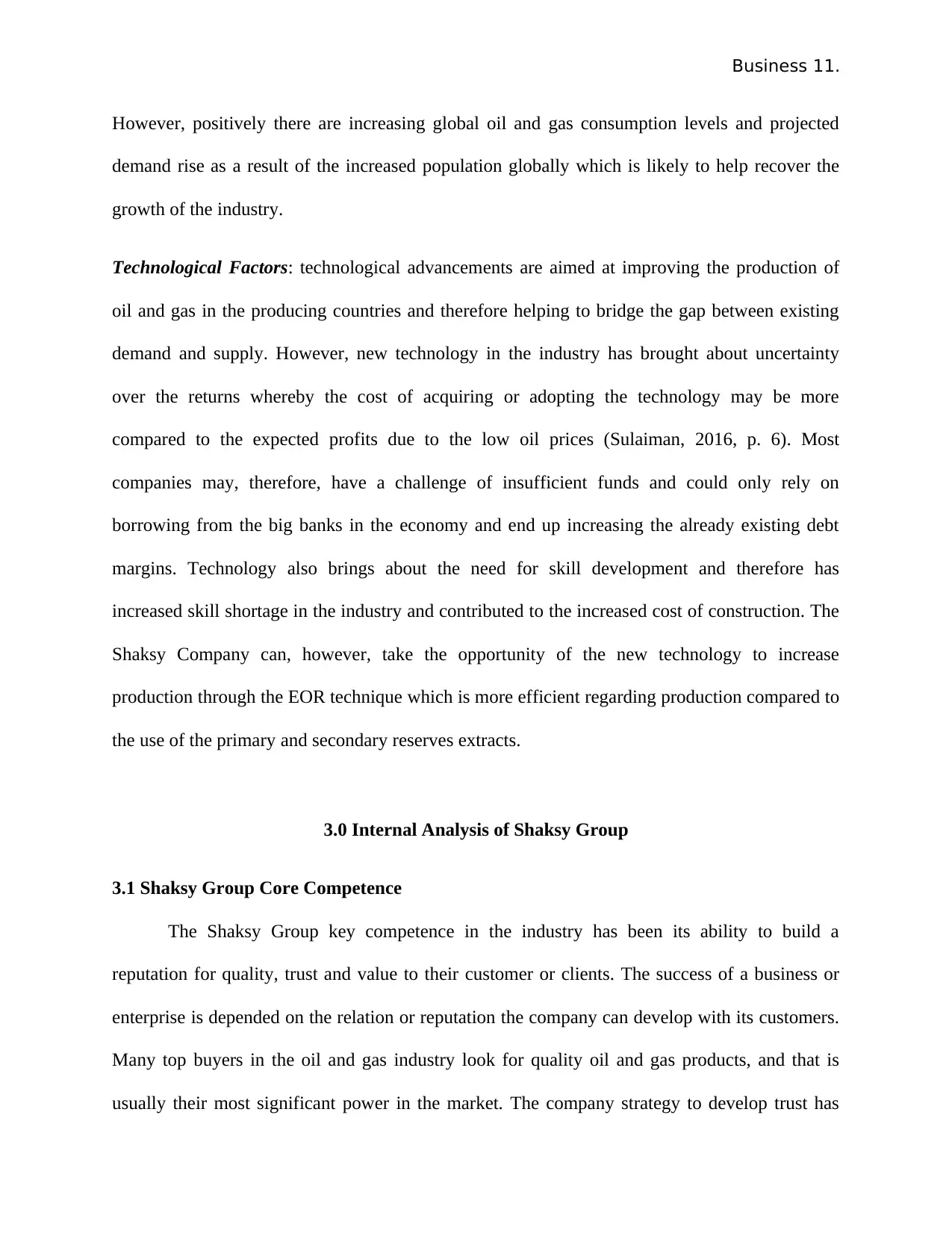
Business 11.
However, positively there are increasing global oil and gas consumption levels and projected
demand rise as a result of the increased population globally which is likely to help recover the
growth of the industry.
Technological Factors: technological advancements are aimed at improving the production of
oil and gas in the producing countries and therefore helping to bridge the gap between existing
demand and supply. However, new technology in the industry has brought about uncertainty
over the returns whereby the cost of acquiring or adopting the technology may be more
compared to the expected profits due to the low oil prices (Sulaiman, 2016, p. 6). Most
companies may, therefore, have a challenge of insufficient funds and could only rely on
borrowing from the big banks in the economy and end up increasing the already existing debt
margins. Technology also brings about the need for skill development and therefore has
increased skill shortage in the industry and contributed to the increased cost of construction. The
Shaksy Company can, however, take the opportunity of the new technology to increase
production through the EOR technique which is more efficient regarding production compared to
the use of the primary and secondary reserves extracts.
3.0 Internal Analysis of Shaksy Group
3.1 Shaksy Group Core Competence
The Shaksy Group key competence in the industry has been its ability to build a
reputation for quality, trust and value to their customer or clients. The success of a business or
enterprise is depended on the relation or reputation the company can develop with its customers.
Many top buyers in the oil and gas industry look for quality oil and gas products, and that is
usually their most significant power in the market. The company strategy to develop trust has
However, positively there are increasing global oil and gas consumption levels and projected
demand rise as a result of the increased population globally which is likely to help recover the
growth of the industry.
Technological Factors: technological advancements are aimed at improving the production of
oil and gas in the producing countries and therefore helping to bridge the gap between existing
demand and supply. However, new technology in the industry has brought about uncertainty
over the returns whereby the cost of acquiring or adopting the technology may be more
compared to the expected profits due to the low oil prices (Sulaiman, 2016, p. 6). Most
companies may, therefore, have a challenge of insufficient funds and could only rely on
borrowing from the big banks in the economy and end up increasing the already existing debt
margins. Technology also brings about the need for skill development and therefore has
increased skill shortage in the industry and contributed to the increased cost of construction. The
Shaksy Company can, however, take the opportunity of the new technology to increase
production through the EOR technique which is more efficient regarding production compared to
the use of the primary and secondary reserves extracts.
3.0 Internal Analysis of Shaksy Group
3.1 Shaksy Group Core Competence
The Shaksy Group key competence in the industry has been its ability to build a
reputation for quality, trust and value to their customer or clients. The success of a business or
enterprise is depended on the relation or reputation the company can develop with its customers.
Many top buyers in the oil and gas industry look for quality oil and gas products, and that is
usually their most significant power in the market. The company strategy to develop trust has
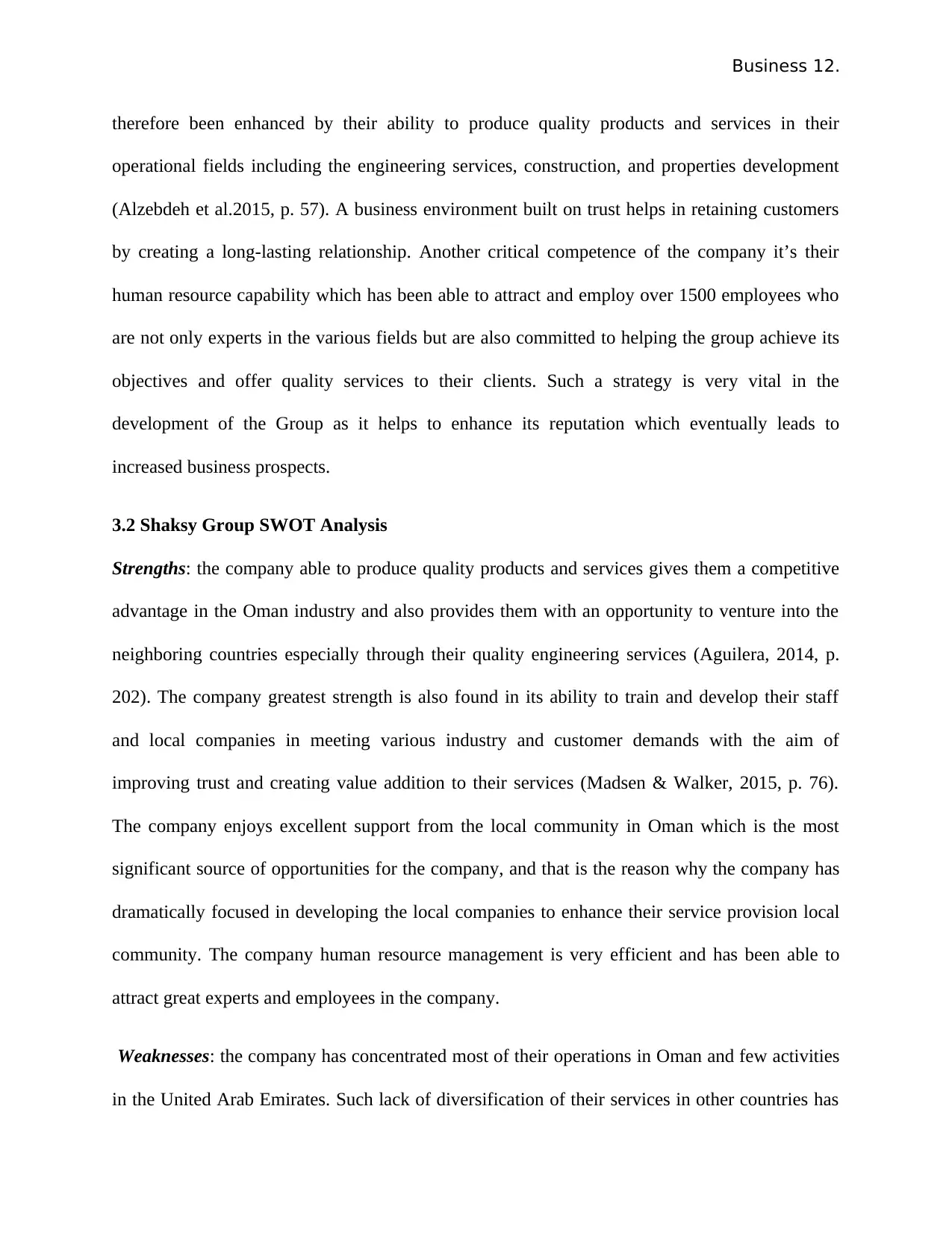
Business 12.
therefore been enhanced by their ability to produce quality products and services in their
operational fields including the engineering services, construction, and properties development
(Alzebdeh et al.2015, p. 57). A business environment built on trust helps in retaining customers
by creating a long-lasting relationship. Another critical competence of the company it’s their
human resource capability which has been able to attract and employ over 1500 employees who
are not only experts in the various fields but are also committed to helping the group achieve its
objectives and offer quality services to their clients. Such a strategy is very vital in the
development of the Group as it helps to enhance its reputation which eventually leads to
increased business prospects.
3.2 Shaksy Group SWOT Analysis
Strengths: the company able to produce quality products and services gives them a competitive
advantage in the Oman industry and also provides them with an opportunity to venture into the
neighboring countries especially through their quality engineering services (Aguilera, 2014, p.
202). The company greatest strength is also found in its ability to train and develop their staff
and local companies in meeting various industry and customer demands with the aim of
improving trust and creating value addition to their services (Madsen & Walker, 2015, p. 76).
The company enjoys excellent support from the local community in Oman which is the most
significant source of opportunities for the company, and that is the reason why the company has
dramatically focused in developing the local companies to enhance their service provision local
community. The company human resource management is very efficient and has been able to
attract great experts and employees in the company.
Weaknesses: the company has concentrated most of their operations in Oman and few activities
in the United Arab Emirates. Such lack of diversification of their services in other countries has
therefore been enhanced by their ability to produce quality products and services in their
operational fields including the engineering services, construction, and properties development
(Alzebdeh et al.2015, p. 57). A business environment built on trust helps in retaining customers
by creating a long-lasting relationship. Another critical competence of the company it’s their
human resource capability which has been able to attract and employ over 1500 employees who
are not only experts in the various fields but are also committed to helping the group achieve its
objectives and offer quality services to their clients. Such a strategy is very vital in the
development of the Group as it helps to enhance its reputation which eventually leads to
increased business prospects.
3.2 Shaksy Group SWOT Analysis
Strengths: the company able to produce quality products and services gives them a competitive
advantage in the Oman industry and also provides them with an opportunity to venture into the
neighboring countries especially through their quality engineering services (Aguilera, 2014, p.
202). The company greatest strength is also found in its ability to train and develop their staff
and local companies in meeting various industry and customer demands with the aim of
improving trust and creating value addition to their services (Madsen & Walker, 2015, p. 76).
The company enjoys excellent support from the local community in Oman which is the most
significant source of opportunities for the company, and that is the reason why the company has
dramatically focused in developing the local companies to enhance their service provision local
community. The company human resource management is very efficient and has been able to
attract great experts and employees in the company.
Weaknesses: the company has concentrated most of their operations in Oman and few activities
in the United Arab Emirates. Such lack of diversification of their services in other countries has
⊘ This is a preview!⊘
Do you want full access?
Subscribe today to unlock all pages.

Trusted by 1+ million students worldwide
1 out of 24
Related Documents
Your All-in-One AI-Powered Toolkit for Academic Success.
+13062052269
info@desklib.com
Available 24*7 on WhatsApp / Email
![[object Object]](/_next/static/media/star-bottom.7253800d.svg)
Unlock your academic potential
Copyright © 2020–2025 A2Z Services. All Rights Reserved. Developed and managed by ZUCOL.




